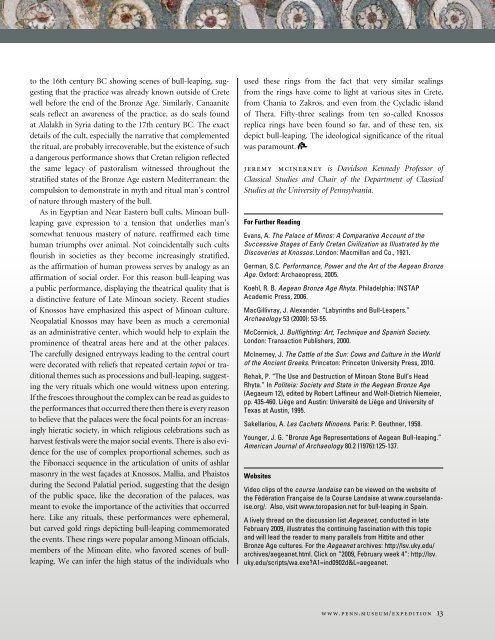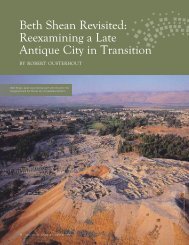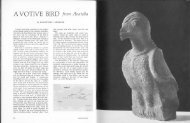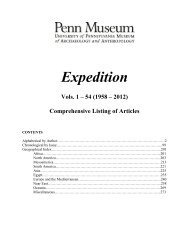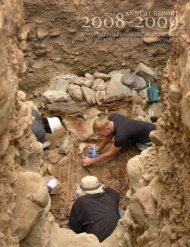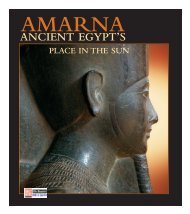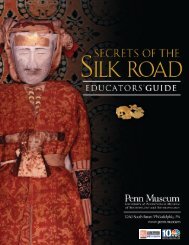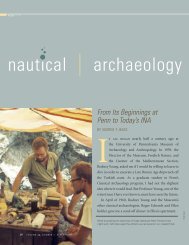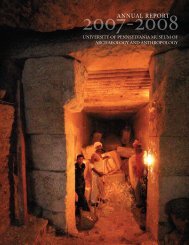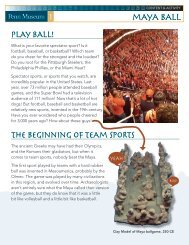Bulls and Bull-leaping in the Minoan World - University of ...
Bulls and Bull-leaping in the Minoan World - University of ...
Bulls and Bull-leaping in the Minoan World - University of ...
Create successful ePaper yourself
Turn your PDF publications into a flip-book with our unique Google optimized e-Paper software.
to <strong>the</strong> 16th century BC show<strong>in</strong>g scenes <strong>of</strong> bull-<strong>leap<strong>in</strong>g</strong>, suggest<strong>in</strong>g<br />
that <strong>the</strong> practice was already known outside <strong>of</strong> Crete<br />
well before <strong>the</strong> end <strong>of</strong> <strong>the</strong> Bronze Age. Similarly, Canaanite<br />
seals reflect an awareness <strong>of</strong> <strong>the</strong> practice, as do seals found<br />
at Alalakh <strong>in</strong> Syria dat<strong>in</strong>g to <strong>the</strong> 17th century BC. The exact<br />
details <strong>of</strong> <strong>the</strong> cult, especially <strong>the</strong> narrative that complemented<br />
<strong>the</strong> ritual, are probably irrecoverable, but <strong>the</strong> existence <strong>of</strong> such<br />
a dangerous performance shows that Cretan religion reflected<br />
<strong>the</strong> same legacy <strong>of</strong> pastoralism witnessed throughout <strong>the</strong><br />
stratified states <strong>of</strong> <strong>the</strong> Bronze Age eastern Mediterranean: <strong>the</strong><br />
compulsion to demonstrate <strong>in</strong> myth <strong>and</strong> ritual man’s control<br />
<strong>of</strong> nature through mastery <strong>of</strong> <strong>the</strong> bull.<br />
As <strong>in</strong> Egyptian <strong>and</strong> Near Eastern bull cults, M<strong>in</strong>oan bull<strong>leap<strong>in</strong>g</strong><br />
gave expression to a tension that underlies man’s<br />
somewhat tenuous mastery <strong>of</strong> nature, reaffirmed each time<br />
human triumphs over animal. Not co<strong>in</strong>cidentally such cults<br />
flourish <strong>in</strong> societies as <strong>the</strong>y become <strong>in</strong>creas<strong>in</strong>gly stratified,<br />
as <strong>the</strong> affirmation <strong>of</strong> human prowess serves by analogy as an<br />
affirmation <strong>of</strong> social order. For this reason bull-<strong>leap<strong>in</strong>g</strong> was<br />
a public performance, display<strong>in</strong>g <strong>the</strong> <strong>the</strong>atrical quality that is<br />
a dist<strong>in</strong>ctive feature <strong>of</strong> Late M<strong>in</strong>oan society. Recent studies<br />
<strong>of</strong> Knossos have emphasized this aspect <strong>of</strong> M<strong>in</strong>oan culture.<br />
Neopalatial Knossos may have been as much a ceremonial<br />
as an adm<strong>in</strong>istrative center, which would help to expla<strong>in</strong> <strong>the</strong><br />
prom<strong>in</strong>ence <strong>of</strong> <strong>the</strong>atral areas here <strong>and</strong> at <strong>the</strong> o<strong>the</strong>r palaces.<br />
The carefully designed entryways lead<strong>in</strong>g to <strong>the</strong> central court<br />
were decorated with reliefs that repeated certa<strong>in</strong> topoi or traditional<br />
<strong>the</strong>mes such as processions <strong>and</strong> bull-<strong>leap<strong>in</strong>g</strong>, suggest<strong>in</strong>g<br />
<strong>the</strong> very rituals which one would witness upon enter<strong>in</strong>g.<br />
If <strong>the</strong> frescoes throughout <strong>the</strong> complex can be read as guides to<br />
<strong>the</strong> performances that occurred <strong>the</strong>re <strong>the</strong>n <strong>the</strong>re is every reason<br />
to believe that <strong>the</strong> palaces were <strong>the</strong> focal po<strong>in</strong>ts for an <strong>in</strong>creas<strong>in</strong>gly<br />
hieratic society, <strong>in</strong> which religious celebrations such as<br />
harvest festivals were <strong>the</strong> major social events. There is also evidence<br />
for <strong>the</strong> use <strong>of</strong> complex proportional schemes, such as<br />
<strong>the</strong> Fibonacci sequence <strong>in</strong> <strong>the</strong> articulation <strong>of</strong> units <strong>of</strong> ashlar<br />
masonry <strong>in</strong> <strong>the</strong> west façades at Knossos, Mallia, <strong>and</strong> Phaistos<br />
dur<strong>in</strong>g <strong>the</strong> Second Palatial period, suggest<strong>in</strong>g that <strong>the</strong> design<br />
<strong>of</strong> <strong>the</strong> public space, like <strong>the</strong> decoration <strong>of</strong> <strong>the</strong> palaces, was<br />
meant to evoke <strong>the</strong> importance <strong>of</strong> <strong>the</strong> activities that occurred<br />
here. Like any rituals, <strong>the</strong>se performances were ephemeral,<br />
but carved gold r<strong>in</strong>gs depict<strong>in</strong>g bull-<strong>leap<strong>in</strong>g</strong> commemorated<br />
<strong>the</strong> events. These r<strong>in</strong>gs were popular among M<strong>in</strong>oan <strong>of</strong>ficials,<br />
members <strong>of</strong> <strong>the</strong> M<strong>in</strong>oan elite, who favored scenes <strong>of</strong> bull<strong>leap<strong>in</strong>g</strong>.<br />
We can <strong>in</strong>fer <strong>the</strong> high status <strong>of</strong> <strong>the</strong> <strong>in</strong>dividuals who<br />
used <strong>the</strong>se r<strong>in</strong>gs from <strong>the</strong> fact that very similar seal<strong>in</strong>gs<br />
from <strong>the</strong> r<strong>in</strong>gs have come to light at various sites <strong>in</strong> Crete,<br />
from Chania to Zakros, <strong>and</strong> even from <strong>the</strong> Cycladic isl<strong>and</strong><br />
<strong>of</strong> Thera. Fifty-three seal<strong>in</strong>gs from ten so-called Knossos<br />
replica r<strong>in</strong>gs have been found so far, <strong>and</strong> <strong>of</strong> <strong>the</strong>se ten, six<br />
depict bull-<strong>leap<strong>in</strong>g</strong>. The ideological significance <strong>of</strong> <strong>the</strong> ritual<br />
was paramount.<br />
jeremy mc<strong>in</strong>erney is Davidson Kennedy Pr<strong>of</strong>essor <strong>of</strong><br />
Classical Studies <strong>and</strong> Chair <strong>of</strong> <strong>the</strong> Department <strong>of</strong> Classical<br />
Studies at <strong>the</strong> <strong>University</strong> <strong>of</strong> Pennsylvania.<br />
For Fur<strong>the</strong>r Read<strong>in</strong>g<br />
Evans, A. The Palace <strong>of</strong> M<strong>in</strong>os: A Comparative Account <strong>of</strong> <strong>the</strong><br />
Successive Stages <strong>of</strong> Early Cretan Civilization as Illustrated by <strong>the</strong><br />
Discoveries at Knossos. London: Macmillan <strong>and</strong> Co., 1921.<br />
German, S.C. Performance, Power <strong>and</strong> <strong>the</strong> Art <strong>of</strong> <strong>the</strong> Aegean Bronze<br />
Age. Oxford: Archaeopress, 2005.<br />
Koehl, R. B. Aegean Bronze Age Rhyta. Philadelphia: INSTAP<br />
Academic Press, 2006.<br />
MacGillivray, J. Alex<strong>and</strong>er. “Labyr<strong>in</strong>ths <strong>and</strong> <strong>Bull</strong>-Leapers.”<br />
Archaeology 53 (2000): 53-55.<br />
McCormick, J. <strong>Bull</strong>fight<strong>in</strong>g: Art, Technique <strong>and</strong> Spanish Society.<br />
London: Transaction Publishers, 2000.<br />
McInerney, J. The Cattle <strong>of</strong> <strong>the</strong> Sun: Cows <strong>and</strong> Culture <strong>in</strong> <strong>the</strong> <strong>World</strong><br />
<strong>of</strong> <strong>the</strong> Ancient Greeks. Pr<strong>in</strong>ceton: Pr<strong>in</strong>ceton <strong>University</strong> Press, 2010.<br />
Rehak, P. “The Use <strong>and</strong> Destruction <strong>of</strong> M<strong>in</strong>oan Stone <strong>Bull</strong>’s Head<br />
Rhyta.” In Politeia: Society <strong>and</strong> State <strong>in</strong> <strong>the</strong> Aegean Bronze Age<br />
(Aegaeum 12), edited by Robert Laff<strong>in</strong>eur <strong>and</strong> Wolf-Dietrich Niemeier,<br />
pp. 435-460. Liège <strong>and</strong> Aust<strong>in</strong>: Université de Liège <strong>and</strong> <strong>University</strong> <strong>of</strong><br />
Texas at Aust<strong>in</strong>, 1995.<br />
Sakellariou, A. Les Cachets M<strong>in</strong>oens. Paris: P. Geuthner, 1958.<br />
Younger, J. G. “Bronze Age Representations <strong>of</strong> Aegean <strong>Bull</strong>-<strong>leap<strong>in</strong>g</strong>.”<br />
American Journal <strong>of</strong> Archaeology 80.2 (1976):125-137.<br />
Websites<br />
Video clips <strong>of</strong> <strong>the</strong> course l<strong>and</strong>aise can be viewed on <strong>the</strong> website <strong>of</strong><br />
<strong>the</strong> Fédération Française de la Course L<strong>and</strong>aise at www.coursel<strong>and</strong>aise.org/.<br />
Also, visit www.toropasion.net for bull-<strong>leap<strong>in</strong>g</strong> <strong>in</strong> Spa<strong>in</strong>.<br />
A lively thread on <strong>the</strong> discussion list Aegeanet, conducted <strong>in</strong> late<br />
February 2009, illustrates <strong>the</strong> cont<strong>in</strong>u<strong>in</strong>g fasc<strong>in</strong>ation with this topic<br />
<strong>and</strong> will lead <strong>the</strong> reader to many parallels from Hittite <strong>and</strong> o<strong>the</strong>r<br />
Bronze Age cultures. For <strong>the</strong> Aegeanet archives: http://lsv.uky.edu/<br />
archives/aegeanet.html. Click on “2009, February week 4”: http://lsv.<br />
uky.edu/scripts/wa.exe?A1=<strong>in</strong>d0902d&L=aegeanet.<br />
www.penn.museum/expedition 13


